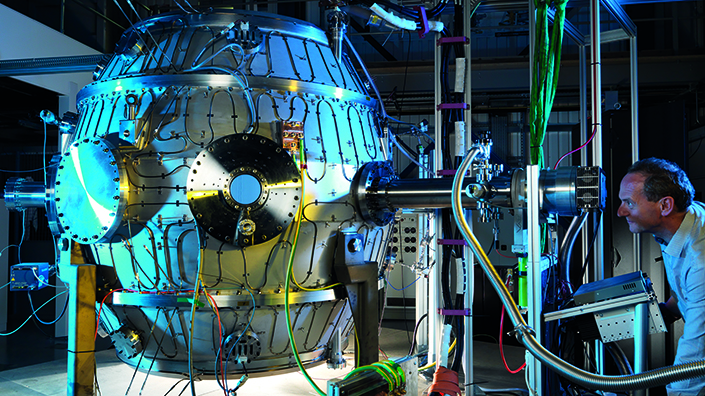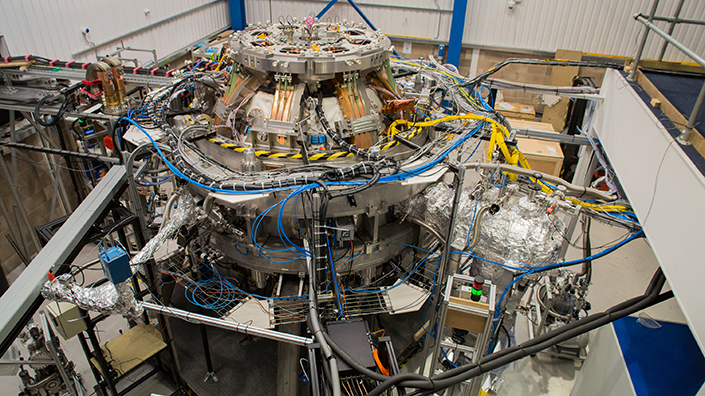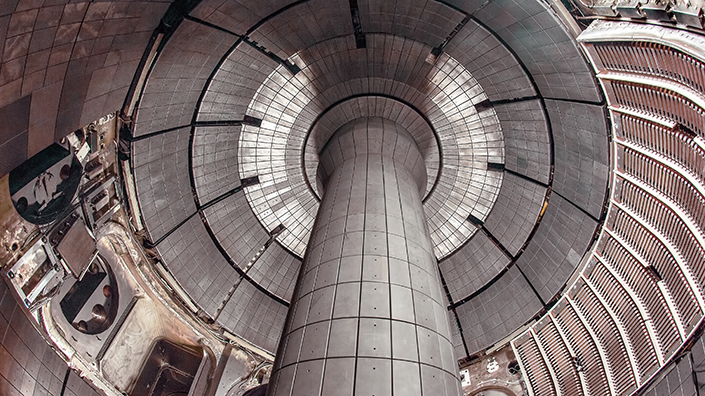On the walls outside Tokamak Energy’s meeting rooms, iPad-sized monitors count down the minutes and anxious red lights signal that those behind glass partitions are not to be disturbed. Jonathan Carling, the firm’s new CEO, a mechanical engineer who spent most of his career in the car business, comes bounding down the stairs, navigating a busy diary.
On the day of our visit, adverts are going live for 17 new jobs at the company – including mechanical engineering roles – under the banner “An extraordinary mission requires extraordinary people”.
In the warehouse, workers are unpacking precious components of a tokamak: an incredible machine designed to replicate what the Sun does at the centre of our solar system. When it next fires up, and if all goes according to plan, it will produce hydrogen plasma at temperatures soaring towards 100m degrees Celsius.
The feverish work is all part of the company’s attempts to develop nuclear fusion, a concept that the sceptics joke will always be 30 years away. But here in Oxfordshire, in an otherwise unremarkable industrial park, it seems almost tangible – a spark in a global effort that could bring virtually unlimited power to us all. Tokamak Energy is part of a new wave of companies and researchers turning away from large, expensive power plants. Nuclear energy has a small future ahead.
No time to waste
It’s been three months since Tokamak Energy moved to its new premises near Oxford and, with plans to test its latest tokamak (imagine a cross between a stainless-steel apple and an antique diving helmet) by the middle of next year, there’s little time to lose. But the real race for Tokamak and its competitors is to find a way to supply clean, reliable energy to help keep global temperatures down.
This mission is more urgent than ever. In October, scientists issued their most dramatic warning yet on the risks of global warming. The Intergovernmental Panel on Climate Change said the world has veered wildly off track from targets set to keep temperatures within 1.5°C above pre-industrial levels. Getting back on track and avoiding ecological catastrophe, said the panel, will require unprecedented changes. Global CO2 emissions will need to be halved within 12 years.
Renewable energy is a crucial part of the solution, but organisations such as the UN’s International Atomic Energy Agency (IAEA) and the World Nuclear Association see nuclear energy as a trusty wingman in the fight. “If we are going to meet the world’s need for affordable and reliable electricity, and do so with technologies that don’t harm the environment, we will need a major contribution from nuclear energy,” says the association’s Jonathan Cobb.
“The nuclear industry has committed to generating 25% of the world’s electricity from nuclear energy by 2050 as part of a low-carbon energy mix.”
Nuclear power today makes up 11% of the world’s electricity cocktail. There are more than 450 large reactors at work and, according to the IAEA, more than 50 new ones are being built (13 of them in China). Heated arguments for and against nuclear energy continue unabated, but what’s not in dispute is that the technology around it is advancing in many different directions.
Safe bets
One of the most exciting directions is small modular reactors (SMRs): smaller nuclear reactors that can be built inside factories and installed wherever they are needed. The IAEA says there is a “flurry of activity” around this “exciting emerging technology” and there are 50 civil SMR concepts at various stages of development.
The UK government is investing in this technology and recently commissioned a study which found that the country is well placed to develop first-of-a-kind small reactors by 2030, with the right policy, risk management and private investment.
For any government, building large nuclear power stations, like the £20bn Hinkley Point C, is a “huge bet”, explains Giorgio Locatelli, who teaches at the school of civil engineering at the University of Leeds. They take years to design and build, are difficult to fund and are exposed to a wide range of risks, such as anti-nuclear referendums. Big projects require commitment to a single technology and can run behind schedule and over budget.

SMRs could be a safer bet for investment than large-scale nuclear power stations
If the bet pays off, says Locatelli, and a major power plant comes online, a utility has a “machine printing money” for 50 or 60 years. But big bets run the risk of big losses. SMRs allow utilities to place smaller, more manageable bets on nuclear energy.
The idea of SMRs is not new, and nuclear-powered military vessels have prowled the seas for decades. The current hype around civil nuclear is “a resurgence” rather than a revolution. Instead of aiming to produce gigawatts of electricity (Hinkley Point C will generate 3.2GW), SMRs settle for more modest targets, ranging from as little as 30MW to 400MW per unit.
“Nuclear power was born small,” explains Locatelli. “But, because of economies of scale, civil power plants grew bigger and bigger.” SMR technologies rely instead on the economies of multiples: the more you make, the cheaper they get. Eventually, running side by side, these reactors could inject significant amounts of electricity into the grid, while being regularly upgraded. They could power towns or reach remote areas, transported on trucks or barges. They could also support renewable energy, providing back-up on a cloudy day or a windless week.
Shrinking reactors
The first SMR is yet to be completed, but most of those under construction rely on existing, nuclear fission technology. By splitting atoms and heating water, which runs through closed circuits of pipes, a giant “kettle” is boiled and the energy is used to generate electricity, usually with the help of a turbine. New methods, including using molten salts, are being developed, and new applications, such as heating (as a byproduct), are being explored.
Moltex Energy, a UK-based company, is developing compact, stable salt reactors and says it believes they will be far safer than their predecessors. “The goal is to have a 300MW reactor operational within 10 years,” says CEO Stephen Haighton. “This will be a fully commercial prototype and will be part of a strategy to replace coal plants that have to be closed.”
Rolls-Royce is leading a British consortium that is reimagining the entire concept of a nuclear power plant, shrinking not only the reactor but all supporting infrastructure. The vision is to build smaller nuclear stations (a tenth of the size of a typical plant), allowing them to be owned and managed by the private sector.
“We’re applying innovation to reduce the biggest cost and risk points, for example construction delays due to poor weather and large components requiring manufacturing on site,” says David Orr, Rolls-Royce’s executive vice-president for small modular reactors. “We’re tackling these challenges one by one to create a simpler, quicker and cheaper way of building a power station.” The company believes SMRs can unlock an export market worth hundreds of billions of pounds and create tens of thousands of skilled jobs.
Russia’s state energy company, Rosatom, has taken the SMR concept onto the Arctic Ocean, and is finishing a floating power plant that can keep heaters burning and kettles boiling in a town with up to 100,000 residents. The 70MW Akademik Lomonosov barge is due to be commissioned in 2019.
SMRs using existing water-cooled fission technology will no doubt reach the market sooner, and 2019 is shaping up to be an important year for various concepts, but companies like Tokamak Energy have their eye on a different SMR prize: compact nuclear fusion.
Over to the engineers
With breakthroughs in high-temperature superconductor materials, and with the physics better understood, the challenge has largely become an engineering one.
Nuclear fusion occurs when super-heated particles collide and release energy. These collisions occur inside a charged, soup-like plasma. While the Sun is pretty good at heating things up and keeping all that energy contained using gravity, humans have to design “magnetic bottles” (tokamaks) or use lasers to create the plasma, and then to stabilise it long enough for fusion to take place. Once fusion occurs, the energy released can be used to generate electricity.
The trouble is, this is as difficult as it sounds. Super-heating the “soup” means reaching temperatures of 100m degrees Celsius or more. To date, Tokamak Energy has managed 15m degrees, while the world record for spherical devices is 70m degrees.
To contain the plasma, the magnetic fields must be immensely powerful. With new superconductor materials in tomorrow’s magnets, there is talk of pushing the magnetic fields into realms where the pressure would be greater than at the bottom of the deepest ocean. Stronger magnets make for better fusion but, at that crushing pressure, it all gets a bit murky.

'Immensely powerful' magnetic fields are needed to contain plasma
Size is also an issue. While the giant 23,000-tonne ITER tokamak is being built in France by a consortium of 35 nations, the team in Oxfordshire is doing the same physics in a warehouse. Tokamak Energy has also moved away from the traditional doughnut-shaped reactor (the ITER model) and towards a spherical shape.
But perhaps the greatest challenge for any magnetic fusion explorer is how to make it economically viable. Since it takes electricity to heat the plasma, today’s efforts fail to achieve a net energy gain. It takes more electricity to run the tokamak than it can generate. The best effort so far used 35% more electricity than it produced.
For David Kingham, one of Tokamak Energy’s founders and its executive vice-chairman, the answer lies in engineering the right magnets. To supplement research being done on copper-based magnets, superconductor materials such as yttrium or gadolinium barium copper oxides are opening up new frontiers.
“The material is available, but how you turn that into a very high-field magnet is a substantial engineering challenge,” says Kingham. “And when we’re talking about going up from megajoules towards gigajoules of stored energy in magnet systems, we have to think about the protection of the magnet in the event of a sudden quench or loss of superconductivity. We’re having to find new solutions to that problem.”
Kingham believes the technology will be ready for deployment by the early 2030s. “The evidence that this is a promising route to fusion power is very strong,” he says.
Tokamak time warps
Fusion expert Sir Steven Cowley, who was recently knighted for his contribution to the field, says he is encouraged by privately funded research into compact fusion, but is not convinced by the timelines. Cowley, the new director of the Princeton Plasma Physics Laboratory in New Jersey, says it’s more likely that fusion energy will come of age around 2050, but may not be widely deployed until decades later.
“It’s a no-brainer. Fusion will take over,” says Cowley. “It’s compact, safe, available everywhere and there’s no waste. It’s the perfect way to make energy. But the difficulty is that we haven’t had all the right ideas yet. We’ve had some, but not all.”
Cowley says no private company has got close to a 100m-degree plasma burn and there are no sure answers yet for how to physically support the proposed magnetic fields, which may unlock the commercial potential of fusion. “One of the reasons we like nuclear fusion research is because it’s really hard,” Cowley adds.

'The perfect way to make energy'?
Tokamak Energy, which is supported by the IMechE through its Stephenson Fund, is undaunted and has filed more than 30 patents and produced influential scientific papers. For engineers, says Kingham, there are tantalising challenges to solve, such as integrating tokamaks into wider auxiliary systems and figuring out new applications for the heat that is generated.
Tokamak Energy has its sights set on a 150MW SMR that takes a year to build and another year to install, measures no more than 10m in any direction once inside its cylinder, and costs less than £1bn to create. The company hopes to produce its first net energy gain by 2025.
“Are we going to sit back and let people in other countries do this, or are we going to compete and win the race?” Kingham asks. It’s clear which side he’s backing.
Carling, the man in charge of Tokamak Energy’s daily journey, is optimistic about what he calls “real engineering”. “We’re engineering and integrating subsystems that don’t exist… where there’s no template. And that’s very exciting to engineers,” he says. “We will deliver fusion power.”
Content published by Professional Engineering does not necessarily represent the views of the Institution of Mechanical Engineers.